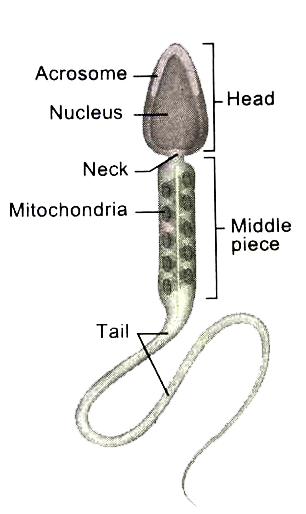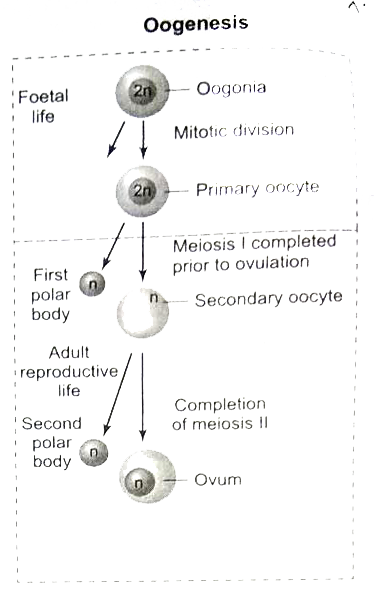Explain the process of oogenesis.Solution in Tamil
Oogenesis is the process of development of the female gamete or ovum or egg in the ovaries. During foetal development, certain cells in the germinal epithelium of the foetal ovary divide by mitosis and produce millions of egg mother cells or oogonia. No more oogonia are formed or added after birth. The oogonial cells start dividing and enter into Prophase-I of meiotic division-I to form the primary oocytes which are temporarily arrested at this stage. The primary oocytes then get surrounded by a single layer of granulosa cells to form the primordial or primary follicles. A large number of follicles degenerate during the period from birth to puberty, so at puberty only 60,000 to 80,000 follicles are left in each ovary.
The primary follicle gets surrounded by many layers of granulosa cells and a new theca layer to form the secondary follicle. A fluid filled space, the antrum develops in the follicle and gets transformed into a tertiary follicle. HTe interna and an outer theca externa. At this time, the primary oocyte within the tertiary follicle division and forms the secondary oocyte . It is an unequal division resulting in the formation of a large haploid secondary oocyte and a first polar body .The first polar body disintegrates. During fertilization , the secondary oocyte undergoes second meiotic division and produces a large cell, the ovum and a second polar body. The second polar body also degenerates. The tertiary follicle eventually becoms a mature follicle or Graafian follicle. If fertilisation does not take place, second meiotic diivision is never completed and the egg disintegrates . At the end of gametogenesis in females, each primary oocyte gives rise to only one haploid ovum.


Related Playlists
- BOOK - FULL MARKSCHAPTER - HUMAN REPRODUCTIONEXERCISE - Higher Order Thinking Skills (HOTs) Questions4videos
HUMAN REPRODUCTION
- BOOK - FULL MARKSCHAPTER - HUMAN REPRODUCTIONEXERCISE - Additional questions (3-marks questions)22videos
HUMAN REPRODUCTION
- BOOK - FULL MARKSCHAPTER - Human health and diseasesEXERCISE - Additional questions - Higher order thinking skills(HOTs)Questions3videos
Human health and diseases
- BOOK - FULL MARKSCHAPTER - MICROBES IN HUMAN WELFARE EXERCISE - Higher Order Thinking Skill (HOTs) Questions4videos
MICROBES IN HUMAN WELFARE
Similar Questions
Give the alternate terminologies for (a) Spermatogonia (b) Embryonic ectoderm
01:21View SolutionWhat is organogenesis?
02:58View SolutionIdentify the mismatched pair and give reason.
(a)Plague-Yersinia pestis
(b)Filariasis-Wuchereria bancrofti
(C )Dermatomycosis-Trypanosoma gambiense
(d)Common cold -Rhino virusView SolutionOne can notice large holes in Swiss cheese . Which bacterium is responible for these holes . What are these holes due to ?
03:02View SolutionThe process of spermatogenesis and oogenesis is started respectively at
01:57View SolutionBriefly describle the process of oogenesis .
03:27View Solutionअण्डजनन क्या है अण्डजनन की संक्षिप्त व्याख्या करे
03:42View SolutionWhat is oogenesis? Briefly describe the process of oogenesis in human female?
05:19View SolutionDefine oogenesis. Explain the stages of oogenesis.
03:28View SolutionExplain oogenesis with a schematic representation
03:41View SolutionExplain oogenesis in female with chart
View SolutionExplain the process of oogenesis in human being.
02:46View SolutionWhat is Oogenesis ? Briefly describe the process of Oogenesis in human female.
04:34View SolutionDescribe the process of Oogenesis.
12:51View SolutionDescribe the process of oogenesis.
03:31View Solution

